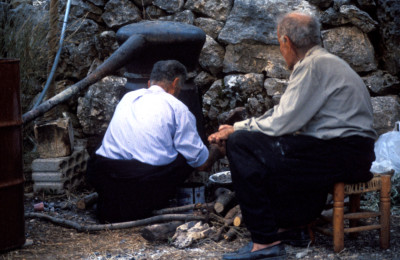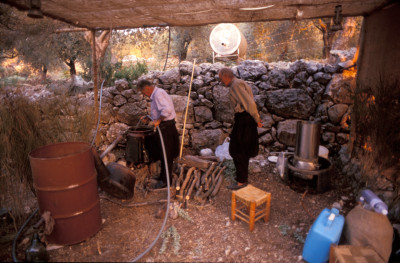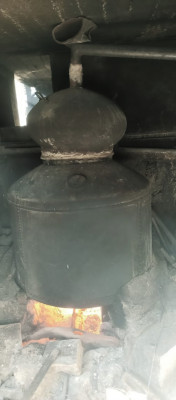Arak
 Arak is a grape brandy found in many Middle Eastern countries, including Lebanon, Syria, Jordan, and Palestine, as well as other regions. This beverage originated in the Fertile Crescent but has since spread to other parts of the world. It’s an ancient craft that has been passed down from generation to generation, right up to the present day. The term “Arak” literally means “sweat” in Arabic. This likely alludes to the condensation process that takes place during distillation, when the alcohol vapor rises and transforms into droplets when exposed to the cold.
Arak is a grape brandy found in many Middle Eastern countries, including Lebanon, Syria, Jordan, and Palestine, as well as other regions. This beverage originated in the Fertile Crescent but has since spread to other parts of the world. It’s an ancient craft that has been passed down from generation to generation, right up to the present day. The term “Arak” literally means “sweat” in Arabic. This likely alludes to the condensation process that takes place during distillation, when the alcohol vapor rises and transforms into droplets when exposed to the cold.
 Traditionally, Arak is made from fermented grape juice. The Obeïdi grape variety is preferred because it offers a good alcohol yield right from the first distillation. To produce 1 liter of Arak, approximately five to seven kilograms of grapes and 0.07 grams of aniseed are required. The production season, which follows that of the grapes, runs from October to December. The first stage of production involves pressing the grapes in a press to extract the juice, which then ferments for about a week. The natural yeasts in the grapes “eat” the sugar in the juice, transforming it into alcohol. The alcohol content is then around 15% ABV. Once the juice has fermented, the first distillation is traditionally carried out in a copper still, to separate the alcohol from the grape juice at around 45% ABV. Traditionally, two further distillations follow suit. The second distillation yields an alcohol content of about 73%, while the third incorporates aniseed, often sourced from the Damascus region of Syria. Some may introduce aniseed as early as in the second distillation. The Arak is eventually placed in terracotta jars to release gas, with an average resting period of approximately six months. Water is gradually added to adjust the alcohol level to around 53% ABV.
Traditionally, Arak is made from fermented grape juice. The Obeïdi grape variety is preferred because it offers a good alcohol yield right from the first distillation. To produce 1 liter of Arak, approximately five to seven kilograms of grapes and 0.07 grams of aniseed are required. The production season, which follows that of the grapes, runs from October to December. The first stage of production involves pressing the grapes in a press to extract the juice, which then ferments for about a week. The natural yeasts in the grapes “eat” the sugar in the juice, transforming it into alcohol. The alcohol content is then around 15% ABV. Once the juice has fermented, the first distillation is traditionally carried out in a copper still, to separate the alcohol from the grape juice at around 45% ABV. Traditionally, two further distillations follow suit. The second distillation yields an alcohol content of about 73%, while the third incorporates aniseed, often sourced from the Damascus region of Syria. Some may introduce aniseed as early as in the second distillation. The Arak is eventually placed in terracotta jars to release gas, with an average resting period of approximately six months. Water is gradually added to adjust the alcohol level to around 53% ABV.
 In Lebanon, Arak is prepared in wine-growing regions, notably within the Christian and Druze communities. The entire production process is traditionally undertaken by men. During the production season, evening gatherings are organized to kill time while keeping an eye on the alembic. The men come together to tell stories, sing songs, and share news. It’s an opportunity to strengthen social ties. The Arak produced is used for domestic consumption, particularly during family gatherings, celebrations, and special occasions, or sold on the market.
In Lebanon, Arak is prepared in wine-growing regions, notably within the Christian and Druze communities. The entire production process is traditionally undertaken by men. During the production season, evening gatherings are organized to kill time while keeping an eye on the alembic. The men come together to tell stories, sing songs, and share news. It’s an opportunity to strengthen social ties. The Arak produced is used for domestic consumption, particularly during family gatherings, celebrations, and special occasions, or sold on the market.
A law that came into effect in 1937 stipulated that “the name Arak may only be used for liqueurs produced by fermenting grapes and distilling them through aniseed seeds”. Arak also had to undergo a triple distillation (traditional method) and be aged for at least 6 months. In 1997, a new decree (Libnor standards permitted the use of the term “Arak” for beverages produced with industrial spirits (such as molasses, beet, date) and flavored with ingredients other than anise (e.g., licorice, fennel, mastic), as long as the ingredients were listed on the bottle. This relaxation of the 1937 law was prompted by winery closures following the Syrian invasion in 1976 and the increasing grape scarcity, particularly in the 1990s, as many estates began to favor wine production since wine was then gaining popularity.

